Surveillance Research Program Bulletin–Fall 2008
Contents
- Highlights
- Employment Opportunities
- Training and Meeting Opportunities
- Funding Opportunities
- SRP Staff News
- Recent SRP Publications
- Selected SRP Grantee Publications
- SEER Registry Staff News
- SEER Kicks Off Visioning Process
- Recent SEER Publications
- CISNET Staff Profile
- Selected CISNET Publications
- Staff Directory
The Surveillance Research Program (SRP) directs the collection and analysis of data to answer key questions about cancer incidence, morbidity, mortality, and cancer-related health status in diverse regions and populations in the United States.
Highlights
SEER Releases New Web Site
Launched September 3, 2008, the new Surveillance, Epidemiology, and End Results (SEER) Web site provides users with easy access to data regarding the incidence, prevalence, survival, and mortality rates of cancers from specific geographic areas throughout the United States. The site is intended for use not only by researchers and cancer registrars, but also by policy, legislative, and cancer control planning staff at all levels of government, as well as advocacy and professional groups.
The new SEER Web site is easier to navigate and more user friendly. Redundant Web pages have been eliminated, and tabs have been added to simplify browsing. In addition, hyperlinks on the left side of lower pages provide easy access to important programs and research activities, and cancer statistics fact sheets and monographs are now immediately available through the homepage.
SEER Releases New Residual Tissue Repository Web Site
Also launched September 3, 2008, the Residual Tissue Repository (RTR) Web site is a resource and tool for cancer researchers, scientists, principal investigators, and epidemiologists who wish to perform biospecimen studies on samples of cancer cases from particular population-based registries. The site contains information on how investigators may apply for specimens and related data. Variables of interest that may be requested for research include demographic information, treatment data, and incidence and survival rates for different types of cancers. A benefit of obtaining specimens from SEER registries is that scientists may access related data maintained by SEER for the cancer of interest. The RTR will enable researchers to perform studies that identify prognostically useful biomarkers that contribute to the goal of reducing the burden of cancer.
New AI/AN Monograph
An Update on Cancer in American Indians and Alaska Natives, 1999-2004

This supplemental monograph combines cancer incidence data from the National Program of Cancer Registries and the SEER Program, along with record linkages and geographic factors, to provide a comprehensive description of the cancer burden in the American Indian/Alaska Native population in the United States. Each chapter addresses a different issue unique to this population. The monograph is intended to educate medical providers and the public about challenges faced by this ethnic group and provides an impetus for further research aimed at improving survival rates and quality of life for members of this community.
Supplement: An Update on Cancer in American Indians and Alaska Natives, 1999-2004. Cancer 2008; 113(S5):1113-1273. Available online at Wiley Online Library .
.
DCCPS/SRP–Embracing Informatics To Support Cancer Surveillance Efforts
When the National Cancer Institute (NCI) launched a 5-year pilot project known as the cancer Biomedical Informatics Grid (caBIG™) in 2004, it envisioned an information network that would employ a grid framework to make databases and analytical services shareable and interoperable. With this grid, all segments of the cancer community–researchers, health care providers, and patients–can make queries across multiple datasets, coordinate data flows in cancer-related molecular science, and share data and knowledge leading to new hypotheses and discoveries.
Working with the caBIG™ Population Sciences Special Interest Group (PS SIG), NCI's Division of Cancer Control and Population Sciences (DCCPS) and Surveillance Research Program (SRP) have embraced health informatics in advancing their information technology efforts. Collaboration between PS SIG and DCCPS/SRP has focused on standardizing the definition and description of data elements to enable computer systems to exchange (syntactic interoperability) and use data with a uniform understanding of the data's meaning (semantic interoperability).
"One of our primary goals is to develop a common ontology. We are trying to identify what needs to be done to move toward a semantic structure," stated Peter Schad, Ph.D., formerly Health Informatics Coordinator, DCCPS. "One of our most important accomplishments is the development of PSG, a PopSci Grid that is a working framework, building on the caBIG™ infrastructure, and that will incorporate tobacco-related, shareable data on a grid."
"Building PSG was a big first step, but we now need to determine the next steps. For instance, we need to focus on data harmonization," added Rick Moser, Ph.D., Research Psychologist, DCCPS, Behavioral Research Program (BRP). "In fact, we are developing a behavioral measures database that will serve as an online archival resource of behavioral measures. It will also promote the use of common data elements (CDEs) which would facilitate data sharing in a standardized format."
Currently, members of the PS SIG are working toward mounting data onto PSG. Collaborations also are underway with SRP to add SEER summary data and biostatistical modeling analytic services to the grid, thus allowing various data sources to be connected into an "interoperable grid of population sciences resources."
"While PSG is still rudimentary, it has provided first proof of concept," stated Brad Hesse, Ph.D., Chief, Health Communication and Informatics Research Branch, BRP. "With PSG, we are concentrating on lung cancer and its relationship with tobacco use. Given that lung cancer is a leading cause of death in the United States, it is a topic that many can relate to and that can be thoroughly analyzed through various fields of expertise, including medicine, psychology, microbiology, and biostatistics."
Recognizing the potential of PSG, Drs. Schad and Hesse continued, "We have the technology in place to obtain the data. In the future, we hope to demonstrate their function and then build the applications that can make the data useable for the population sciences community and, thereby, help support its members' cancer control efforts."
2008 Annual caBIG™ Meeting Recap

The fifth Annual caBIG™ Meeting was held in Washington, DC, June 23-25, 2008. As noted previously, caBIG™ is "an information network that enables all constituencies in the cancer community (i.e., researchers, physicians, and patients) to share data and knowledge."
At the meeting, Noshir Contractor, Ph.D., of Northwestern University, showed that it is possible to link tobacco-related data from two different health-related surveys (NHANES and NHIS) by creating CDEs for these surveys. Dr. Contractor's lecture was so well received that he plans to add tobacco tax data and Geographic Information Systems (GIS) capabilities to further demonstrate grid-enabled technology at the fall caBIG™ PopSci SIG Face-to-Face (F2F) meeting.
CSB Staff Participates in NAACCR Annual Meeting

Cancer Statistics Branch (CSB) staff members attended and contributed to the Annual Meeting and Workshops of the North American Association of Central Cancer Registries (NAACCR), June 7-14 in Denver CO. This year's conference, entitled "Ascending New Heights in Cancer Surveillance," highlighted "the future directions of cancer surveillance in light of emerging technologies in cancer detection and treatment, innovations in registry operations and data analysis methodologies, and survivorship issues." The program included various workshops and seminars that were sponsored and presented by staff members from CSB, with topics ranging from the importance of data quality to cancer registrar training, including the following.
Barry Miller, Dr.P.H., presented a poster entitled "Cancer Incidence Among Specific Asian and Pacific Islanders in the U.S." In this study, Dr. Miller linked detailed racial and ethnic population data from the 2000 U.S. Decennial Census to incidence information for Asian Indians/Pakistanis, Chinese, Filipinos, Guamanians, Native Hawaiians, Japanese, Kampucheans, Koreans, Laotians, Samoans, Tongans, and Vietnamese. He then evaluated cancer incidence patterns and noted health disparities relative to the non-Hispanic white population. A significant outcome of this study was the creation of various new data resources for cancer researchers.
Nadia Howlader, M.S., presented a poster on Myelodysplastic Syndromes (MDS) and Chronic Myeloproliferative Disorders (CMD). For this study, Ms. Howlader analyzed data from NAACCR to evaluate trends in MDS and CMD incidence and survival, estimate case numbers for the entire United States, and assess trends in diagnostic recognition and reporting. Overall she found that, from 2001-2004, males experienced a higher mortality rate than females; MDS incidence rates significantly increased during this 3-year period. Only 4 percent of all cases were reported to registries by physicians' offices, however, so the incidence and prevalence of MDS throughout the United States may be underestimated.
Lois Dickie, C.T.R., and Carol Johnson, C.T.R., held a training session entitled "Cancer Registrar Training: A Model To Meet Today's Challenges." The objective of this session was to discuss multilevel methods that can be used to train new registrars or to introduce new coding systems in different registry settings.
Peggy Adamo, R.H.I.T., C.T.R., Dave Stinchcomb, M.A., M.S., and Antoinette Percy-Laurry, M.S.P.H., presented a poster entitled "Evaluating Quality Standards for Geographic Data." The purpose of this poster was to "present an evaluation of additional metrics to assess the accuracy of census tract data with a goal of establishing reasonable quality standards." SEER proposed to establish separate quality standards for rural and urban areas and provide assurance of quality census tract values for all SEER areas. These additional quality measures could also be applied in other cancer registries to increase the overall quality of geographic data.
Marie-Jo Horner, M.S.P.H., gave a presentation entitled "Feasibility Study on Delay-Adjustment of U.S. Cancer Rates Using SEER and NPCR Registries." The purpose of this study was to evaluate registry-specific operations that could impact implementation of the delay-adjustment model in registries outside of SEER.
Carol Kosary, M.A., gave a presentation entitled "What Is Data Quality? And, While We're At It...What Is Quality?" This presentation discussed various definitions of quality; how these definitions affect how researchers understand, perceive, and define data quality; and the impact that these definitions ultimately will have on data quality.
Jennifer Ruhl, R.H.I.T., C.T.R., disscussed "An Innovative Approach To Improve the Quality of Data Collection for Hematopoietic Diseases." She described existing methods used to collect and compile data on hematopoietic diseases; pros and cons associated with these methods; and potential strategies to streamline collection, storage, and access to data.
Marsha Reichman, Ph.D., gave a presentation entitled "Incidence of Cancer of the Oral Cavity and Pharynx Among American Indians and Alaska Natives, 1999-2004." The purpose of this study was to investigate disparities among American Indian/Alaska Native (AI/AN) populations and non-Hispanic whites (NHW) for cancers of the oral cavity and pharynx. Nasopharyngeal cancer is found more frequently, and tongue cancer is less common among AI/AN populations than NHW. Trends indicated that there were regional variations among the AI/AN populations, as well as differences according to gender. These wide variations indicate an important need for research regarding underlying risk factors. This study was significant because it provides the most comprehensive data for cancers of the oral cavity and pharynx in the AI/AN population to date.
NAACCR currently is accepting abstracts for oral presentations and posters at its upcoming annual meeting in San Diego, CA, June 13-20, 2009. The theme of the conference will be "Charting the Course to a New World in Cancer Surveillance" The conference will highlight "new directions in cancer surveillance with current and future technologies in the diagnosis and treatment of cancer as well as innovation in informatics as it affects cancer data collection." Abstracts may be submitted via mail, courier, or e-mail to Venue West Conference Services and must be received by 5:00 p.m. Pacific Time on Friday, December 5, 2008. Abstracts received after the deadline will not be accepted.
Employment Opportunities
NCI is inviting applications for several positions within SRP, DCCPS. U.S. citizenship or permanent residency is required for Federal positions. The U.S. Department of Health and Human Services (HHS) and the National Institutes of Health (NIH) are equal opportunity employers. For each position, send a letter summarizing your experience and interests and a complete CV, including the names of three references, by electronic mail to the listed contact.
Senior Mathematical Statistician/Program Director
NCI welcomes applications for a mathematical statistician to serve as Program Director for the largest statistical methods grants portfolio at NIH, which currently consists of more than 60 grants and approximately $12 million per year in funding commitments (StatFund website). This senior statistician will interact with current grantees and university statisticians to stimulate new, cutting-edge statistical research in areas of interest to NCI. The position is within the Statistical Research and Applications Branch (SRAB).
Requirements: Doctoral level training and at least 5 years of broad experience in statistics. Knowledge of and experience with the grants process is desirable, as well as an interest in statistical issues relevant to SRAB's mission.
Contact: Eric J. (Rocky) Feuer, Ph.D., Chief, Statistical Research and Applications Branch, rf41u@nih.gov.
Position in Spatial Statistics
SRP has an active program of research in the statistical analysis of spatial and temporal patterns of cancer, spatial data visualization, and GIS. Opportunities exist for collaboration and leadership in the areas of spatial statistics and geographically related analysis throughout NCI and with other NIH Institutes, other Federal agencies, and the extramural research community.
Requirements: A Ph.D. in biostatistics or a related field and experience in spatial statistical methods applications and research, with an emphasis on model-based methods. Experience in one or more of the following areas also is desirable: disease-rate mapping, geovisualization, GIS, and cancer registry data analysis.
Contact: Eric J. (Rocky) Feuer, Ph.D., Chief, Statistical Research and Applications Branch, rf41u@nih.gov.
Positions in Mathematical Statistics and Biostatistics
NCI has several positions available within the SEER Program. Each position includes responsibility for initiating and managing collaborative analyses with scientists from NCI and other Institutes, agencies, and academic centers. Current openings include Senior Mathematical Statistician (minimum 4 years of postdoctoral experience) and Biostatistician (minimum 2 years of postdoctoral experience). Positions also are available for experienced statisticians with a master's degree.
Contact: Judith Swan, M.H.S., Surveillance Research Program, js60y@nih.gov.
Statistician in Population Genetics
SRP invites applications for a statistician with expertise in population genetics. SRP is expanding its program in the area of statistical genetics, including genome-wide association studies and the examination of gene-environment interactions. The position focuses on methodological research and statistical genetics to address methodologic questions in cancer epidemiology.
Requirements: A doctoral degree in biostatistics or statistics and several years of postdoctoral experience related to developing methods in population genetics.
Contact: Eric J. (Rocky) Feuer, Ph.D., Chief, Statistical Research and Applications Branch, rf41u@nih.gov.
Postdoctoral and Sabbatical Positions
SRP invites applications from qualified candidates in the area of cancer surveillance research. The positions range from summer-only to 1-year appointments. Successful candidates will come into contact with scientists and public health professionals representing a variety of research disciplines. Mechanisms include the Cancer Research Training Award (CRTA) and the Intergovernmental Personnel Act (IPA) sabbatical position.
Contact: Eric J. (Rocky) Feuer, Ph.D., Chief, Statistical Research and Applications Branch, rf41u@nih.gov.
For further information on all positions, see: Job Opportunities in Surveillance Research, SEER website.
Training and Meeting Opportunities
The Role of SEER Data in Population-Based Cancer Surveillance Research

Antoinette Percy-Laurry, M.S.P.H., gave a presentation on SEER and its various applications in population-based cancer surveillance during the American Public Health Association's (APHA) 136th Annual Meeting and Expo, October 25-29, 2008, in San Diego, CA. David Stinchcomb, M.A., M.S., and Barry Miller, Dr.P.H., were co-contributors to the presentation.
For further information on this seminar, contact Antoinette Percy-Laurry, M.S.P.H., at percyl@mail.nih.gov.
Funding Opportunities
Program Announcement: Decision Making in Cancer
The Program Announcement (PA) Decision Making in Cancer: Single-Event Decisions (R01, R21) invites applications for research projects that will enhance understanding of human decision making processes so that individuals can make more informed and satisfying choices regarding their health.
Further details can be found at:
SRP Staff News
New Hires at SRP

Lawrence J. Hwang, M.P.H., joined SRP as a Health Communications Intern through a Cancer Research Training Award (CRTA) fellowship in the Division of Cancer Control and Population Sciences (DCCPS), Surveillance Research Program (SRP), in July 2008. Lawrence graduated this year after being enrolled at the State University of New York (SUNY) at Albany School of Public Health in Rensselaer, NY. His previous experience includes working as a preventive medicine intern at the New York State Office for the Aging in Albany, NY, and interning at the New York State Department of Health's AIDS Institute in Albany. He holds a B.A. in psychology and sociology and an M.P.H. from the State University of New York at Geneseo and State University of New York at Albany School of Public Health, respectively. Lawrence's professional interests revolve around preventive medicine and health education. At SRP, he will be involved in updating and creating new fact sheets and tearsheets for DCCPS, updating the Residual Tissue Repository (RTR) Web site, writing the quarterly SRP Bulletin, and working on an outreach project that targets Asians and Pacific Islanders who are at risk for specific types of cancers. He also will be involved with surveillance research and other health promotion projects. When not in the office, Lawrence enjoys spending time with his family and friends, running, hiking, swimming, and learning how to swing dance and lindy hop.

Katrina A. Mackrain, M.P.H., joined DCCPS/SRP in July 2008 as a Health Communications Intern through the CRTA fellowship program. "Kat" graduated this year after being enrolled at New Mexico State University's School of Public Health in Las Cruces, NM. Her previous experience includes working as a research fellow at the Division of Cancer Epidemiology and Genetics in NCI's Nutritional Epidemiology Branch in Rockville, MD, and working as an intern at Botsford Hospital in Farmington Hills, MI. She holds a B.A. in anthropology from the University of Michigan and a B.S. in microbiology and an M.P.H. from New Mexico State University. Kat has a strong interest in epidemiology and data analysis and how they relate to health education and preventive health. At SRP, she will be involved in the creation and development of SRP's orientation packet and in maintaining and updating the SRP Web site and other forms of media for DCCPS. She also will be involved with surveillance research and other health promotion projects. Outside of the office, Kat enjoys yoga, traveling, spending time with her nieces and nephews, and volunteering with "Greater DC Cares." She is an avid runner and currently is training to run a half-marathon.
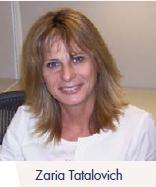
Zaria Tatalovich, Ph.D., joined SRP in August 2008 as a Health Statistician in the Cancer Statistics Branch. Originally from Croatia, Zaria obtained her Ph.D. in geography from the University of Southern California (USC). She also holds a master's in geography, and a master's and B.S. in psychology. Zaria's research combines geospatial technologies and standard statistical and geostatistical methods in the investigation of health risks associated with exposure to adverse social/environmental conditions. This involves developing new methods and models and testing existing ones. Her research emphasizes the importance of understanding the impacts of time, scale, and resolution on the measurements of risk and their spatial representation. Recent projects include modeling potential ultraviolet (UV) exposure across the continental United States or objective assessment of melanoma risk, extrapolation of traffic volume on a local roadway network to support assessment of traffic-related exposure to pollutants, modeling community socioeconomic status for multilevel analysis of individual and neighborhood influence on asthma prevalence, reconstructing historical patterns of social vulnerability at the census tract level, and analysis of neighborhood-level correlates of physical activity. Outside of the office, Zaria likes to eat sweets, socialize, play sports, and watch movies.
Awards
Brenda Edwards and Judith Swan Receive NIH Director's Award

Brenda K. Edwards, Ph.D., and Judith Swan, M.H.S., were awarded the 2008 NIH Director's Award for "outstanding national leadership in cancer surveillance research among Native American and Alaska Native populations."
Dr. Edwards and Ms. Swan have collaborated with government, non-government, and tribal organizations to facilitate the expansion of cancer surveillance among American Indians and Alaska Native (AI/AN) populations, who frequently have poorer health outcomes than the overall U.S. population. Currently, they oversee NCI support for the Cherokee Nation Cancer Registry, the Northwest Portland Area Tribal Registry, and the Network for Cancer Control Research among AI/AN. Over the past decade, they have organized support for many Native American meetings and conferences on cancer, as well as student projects. They have published detailed analyses of Native American cancer rates. Through their leadership, Dr. Edwards and Ms. Swan have significantly improved the knowledge base related to cancer among Native populations and enabled NCI to enlarge its portfolio of cancer control research directed toward ending health disparities. Ms. Swan notes, "I know that NIH recognizes the importance of working with hard-to-reach and vulnerable populations and the need for improving data on them. I am thrilled to receive the award!"
Bill Davis and Rocky Feuer Receive 2008 CDC Statistical Science Award

Drs. Davis and Feuer, of the Statistical Research and Applications Branch (SRAB), received an "Applied Paper" award for their contributions to an article entitled "Combining Information From Two Surveys to Estimate County-Level Prevalence Rates of Cancer Risk Factors and Screening" at the 2008 Statistical Science Awards Ceremony for the Centers for Disease Control and Prevention (CDC) and the Agency for Toxic Substances and Disease Registry in Atlanta, GA. Drs. Davis and Feuer coauthored the paper with Trivellore Raghunathan, Ph.D., of the University of Michigan; Dawei Xie, Ph.D., of the University of Pennsylvania School of Medicine; Nathaniel Schenker, Ph.D., and Van L. Parsons, Ph.D., of the CDC; and Kevin W. Dodd, Ph.D, formerly a statistician at SRAB. Their paper focused on the Behavioral Risk Factor Surveillance System (BRFSS) and the National Health Interview Survey (NHIS), which are commonly used to obtain estimates of the incidence and prevalence of various cancer risk factors and screenings throughout the United States. The paper obtains county-level prevalence estimates utilizing the strength of each survey. In particular, the approach adjusts for the possible non-response and non-coverage biases of the BRFSS telephone survey while using the large BRFSS sample size to increase precision. This article can be found in the June 2007 edition of the Journal of the American Statistical Association.
SEER QI Staff Receives NCI 2008 NIH Merit Award
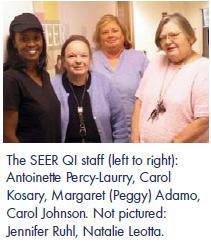
The SEER Quality Improvement/Quality Control (QI) staff was honored with a 2008 NCI NIH Merit Award. Margaret Adamo, R.H.I.T., C.T.R., Carol Johnson, C.T.R., Carol Kosary, M.A., Natalie Leotta, Antoinette Percy-Laurry, M.S.P.H., and Jennifer Ruhl, R.H.I.T., C.T.R., members of the QI staff in SRP's Cancer Statistics Branch (CSB), were recognized with a Merit Award for "sustained efforts in converting to electronic, Web-based processes for quality control of cancer surveillance data." The award was presented by NCI Director Dr. John E. Niederhuber on November 4, 2008.
Brenda Edwards and Judith Swan Receive Phil Smith Award
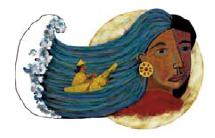
Brenda K. Edwards, Ph.D., and Judith Swan, M.H.S., were awarded the 2008 Native Research Network's Phil Smith Award for "exemplary support to research in Native Communities through direct funding or facilitating mechanisms, policy, or training." The award was presented during the 20th Native Health Research Conference, August 25 to 28, 2008, in Portland OR. The conference was attended by more than 400 participants, and its theme was "Exploring the Interface Between Science and Tradition in Native Health Research."
Other News
Stephen Meersman Rejoins SRP
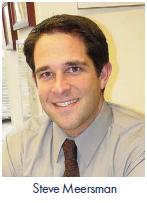
In July 2008, Stephen Meersman, Ph.D., Provision of Care Manager at the Rhode Island Department of Health since 2007, rejoined SRP as a social scientist and researcher. With his extensive experience in health disparities, he will study various issues related to the measurement and analysis of cancer-related health disparities.
While working at the Office of HIV/AIDS and Viral Hepatitis at Rhode Island's Department of Health, Dr. Meersman oversaw Rhode Island's Ryan White HIV/AIDS care and treatment programs, including the AIDS Drug Assistance Program (ADAP). He also served as a liaison between the Health Resources and Services Administration (HRSA) and the RI Department of Health and coordinated Title II-contracted services and affiliated programs.
When asked why he chose to come back to SRP, Dr. Meersman stated, "The staff at SRP is really incredible in so many ways. They are some of the smartest, hardest working, committed, and thoughtful people. I really missed being surrounded by so many talented individuals doing such great work. The opportunity to be part of this group again is truly a privilege. I am thrilled to be back."
Peter Schad Moves to the Cancer Institute of New Jersey
In August 2008, Peter Schad, Ph.D., moved to a new position as an Associate Director for Clinical Informatics at the Cancer Institute of New Jersey. In this position, Dr. Schad will attempt to apply Advanced Mathematical Models (AMM) to analyze and identify unique data signatures within large and complex biological and clinical data.
At SRP, Dr. Schad worked as DCCPS Health Informatics Coordinator. During this time, he was responsible for coordinating with groups inside DCCPS as well as various extramural research facilities such as NIH, CDC, FDA, and HHS.
Antoinette Percy-Laurry Joins Commissioned Corps

In June 2008, Antoinette Percy-Laurry, M.S.P.H., was accepted into the U.S. Public Health Service Commissioned Corps as a Lieutenant Commander (LCDR). Commissioned Corps is an "elite team of well-trained, highly qualified public health professionals who are dedicated to delivering the Nation's public health promotion and disease prevention programs and advancing public health science in the Nation's fight against disease and poor health conditions." Mrs. Percy-Laurry joined the Corps because she felt the need to "go beyond typical professional practice and become one of the Nation's leaders in public health." As a newly inducted member of the Corps, she is mentored by fellow CSB staff members Sean Altekruse, D.V.M., M.P.H., Ph.D., and Barry Miller, Dr.P.H., who are captains in the Commissioned Corps.
Noteworthy Vacations
"Noteworthy Vacations" will occasionally be featured in future editions of the SRP Bulletin. SRP staff members are encouraged to submit interesting and noteworthy photos from their vacations. Send photos and captions to Katrina Mackrain at mackraink@mail.nih.gov.
Margaret (Peggy) Adamo Travels to San Diego
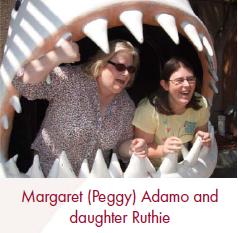
Peggy stated, "My daughter Ruthie and I went to San Diego, CA, in July. San Diego is my hometown, and this was my daughter's first time there. This is a picture of us having some fun at the Birch Aquarium at Scripps in La Jolla."
Marsha Reichman Tours China

Marsha and her husband Jim visited their son James, who was teaching English in Shanghai and who served as their translator and tour guide in Shanghai, Beijing, and Xi'an. According to Marsha, "It was an amazing visit, giving us a chance to see some of new and old China. Seeing the Olympics after our return only increases our interest in a return trip."
Antoinette Percy-Laurry Vacations in the Poconos

Antoinette Percy-Laurry recently celebrated her 15th wedding anniversary with her husband Darnell Laurry in Pennsylvania's Pocono Mountains.
Denise Lewis Goes Sightseeing in Yosemite National Park
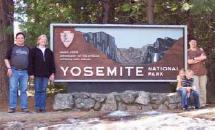
"We visited Yosemite in March, and the snowmelt made the waterfalls absolutely overflow. Snowpack was still too deep to visit the old stands of redwood in the park, but we did visit redwoods in Muir Woods just outside of San Francisco," said Denise.
Barry Miller in Glacier National Park

Barry stated, "I had just reached Logan Pass (Continental Divide, elevation 6,646 ft.) after cycling up the "Highway to the Sun" in Glacier National Park, MT. Wildlife sightings along the way included bear, bighorn sheep, mule deer, mountain goats, ground squirrels, and other crazed cyclists. All-you-can-eat evening meals also helped make this tour memorable."
Recent SRP Publications
An update on cancer in American Indians and Alaska Natives, 1999-2004. Cancer 2008;113(S5):1113-1273.
Harper S, Lynch J, Meersman, SC, Breen N, Davis WW, Reichman ME. An overview of methods for monitoring social disparities in cancer with an example using trends in lung cancer incidence by area-socioeconomic position and race-ethnicity, 1992-2004. Am J Epidemiol. 2008 Apr 15;167(8):889-99. Epub 2008 Mar 15. Comment in: Am J Epidemiol. 2008 Apr 15;167(8):900-4; author reply 908-16.
Reichman ME, Kelly JJ, Kosary CL, Coughlin SS, Jim MA, Lanier AP. Incidence of cancers of the oral cavity and pharynx among American Indians and Alaska Natives, 1999-2004. Cancer. 2008 Sep 1;113(5 Suppl):1256-1265.
Rizzo L, Moser RP, Waldron WR, Wang Z, Davis WW. Analytic Methods to Examine Changes Across Years Using HINTS 2003 and 2005 Data. HINTS: Health Information National Trends Survey. Bethesda, MD: U.S. Department of Health and Human Services; Jun 2008. NIH No. 08-6435.
Selected SRP Grantee Publications
Begg CB, Haile RW, Borg A, Malone KE, Concannon P, Thomas DC, Langholz B, Bernstein L, Olsen JH, Lynch CF, Anton-Culver H, Capanu M, Liang X, Hummer AJ, Sima C, Bernstein JL. Variation of breast cancer risk among BRCA1/2 carriers. JAMA 2008 Jan 9;299(2):194-201.
Haneuse S, Wakefield J. Geographic-based ecological correlation studies using supplemental case-control data. Stat Med 2008 Mar 15;27(6):864-87.
Kerber RA, Amos CI, Yeap BY, Finkelstein DM, Thomas DC. Design considerations in a sib-pair study of linkage for susceptibility loci in cancer. BMC Med Genet 2008 Jul 10;9:64.
Kwee LC, Liu D, Lin X, Ghosh D, Epstein MP. A powerful and flexible multilocus association test for quantitative traits. Am J Hum Genet 2008 Feb;82(2):386-97.
Nan B, Lin X. Analysis of case-control age-at-onset data using a modified case-cohort method. Biom J 2008 Apr;50(2):311-20.
Wang CY, Huang Y, Chao EC, Jeffcoat MK. Expected estimating equations for missing data, measurement error, and misclassification, with application to longitudinal nonignorable missing data. Biometrics 2008 Mar;64(1):85-95. Epub 2007 Jun 30.
Zhong H, Prentice RL. Bias-reduced estimators and confidence intervals for odds ratios in genome-wide association studies. Biostatistics 2008 Oct;9(4):621-34. Epub 2008 Feb 28.
SEER Registry Staff News
Patricia Hammond Retires From SEER
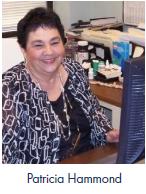
Patricia M. Hammond, Senior Project Coordinator at Emory University, retired in the spring of 2006 after 28 years of employment. During her tenure, she was responsible for collecting followup data from cancer patients in the Atlanta metropolitan area and rural Georgia and sending this data to NCI so it could be used to calculate survival rates after their first course of treatment. She stated, "I felt that this information was important to patients who were diagnosed with cancer and that the data would give them an idea of how their particular type of cancer was diagnosed, and what treatment was used and recommended and would allow them to see the survival rates."
Following her retirement from Emory and the SEER Program, Ms. Hammond now spends her free time with her granddaughter. She also plans to do volunteer work and expects to travel in the near future.
Betsy Kohler Appointed New NAACCR Executive Director
In August 2008, Betsy Kohler, M.P.H., C.T.R., was appointed Executive Director of the North American Association of Central Cancer Registries (NAACCR). NAACCR is a professional organization that develops and promotes uniform data standards for cancer registration; provides education and training; certifies population-based registries; aggregates and publishes data from central cancer registries; and promotes the use of cancer surveillance data and systems for cancer control and epidemiological research, public health programs, and patient care to reduce the burden of cancer in North America.
Prior to becoming NAACCR's Executive Director, Ms. Kohler had extensive experience in the field of cancer epidemiology and surveillance. For the past 30 years, she has been responsible for cancer surveillance in New Jersey and also worked with various NAACCR partners, ranging from the NCI's SEER Program to the CDC's National Program of Cancer Registries (NPCR). She currently is one of North America's representatives to the International Association of Cancer Registries and also received the Distinguished Service Award (Connie Percy Award) in 2002 and the Calum Muir Award in 2008 for her significant contributions to the NAACCR community.
Anne Lanier Receives the Frank Dukepoo Research Award
Anne Lanier, M.D., M.P.H., a 2008 recipient of the Frank Dukepoo Research Award, is a medical epidemiologist with the Alaska Native Tribal Health Consortium in Anchorage, AK. This prestigious award recognizes a senior investigator for promoting integrity, respect, and excellence in Native health research. Dr. Lanier has been a leader in Native health. She was instrumental in the creation of the Alaska Native Tumor Registry. She also has been program director for two Alaska Native Tribal Health Consortium (ANTHC) Native American Research Center for Health (NARCH) programs and other NIH awards. Her goal has been to develop the capacity for culturally competent and clinically relevant health research within the Alaska Tribal Health System. She spearheaded the first of the ongoing Alaska Native Health Research Conferences. This award recognized her "integrity, respect, and excellence spanning a 40-year career as a physician, epidemiologist, and researcher." Dr. Lanier earned her M.D. at Washington University in St. Louis and her M.P.H. at the University of Minnesota. She is board certified by the American College of Preventive Medicine.
SEER Kicks Off Visioning Process
The SEER Program held a 1½-day meeting from April 23-24, 2008, at the Sir Francis Drake Hotel in San Francisco, CA, to discuss a vision for the future of cancer surveillance and the SEER Program, including new directions and strategies. After exchanging ideas about the SEER mission, customers, and constituencies, participants discussed possible future directions, issues, and opportunities. On the final day, ideas were sorted into focus areas, and the participants formed four work groups to address these four areas for SEER below.
- Data use, relevance, and marketing. This group is examining the feasibility of developing approaches for determining customer data needs, identifying partnership opportunities and new funding sources, and evaluating new partners to enhance registry data. Emphasis also will be placed on examining strategies for marketing SEER and its unique values to stakeholders and identifying opportunities for collaborative research. Drs. Sally Glaser and Christina Clarke from the Northern California Cancer Center agreed to chair this work group.
- Core data and timeliness. The objective of this group is to examine strategies for implementing tiered reporting and reporting incidence data earlier, including ways to configure data sets to achieve these goals. Dr. Dennis Deapen of the Los Angeles Cancer Surveillance Program agreed to chair this work group; Dr. Tom Tucker of the Kentucky Cancer Consortium will serve as co-chair.
- Automation and alternative technologies. This group will explore ways to use artificial intelligence, electronic transmission of data, and other technologies for follow-up, rapid reporting, and other operations. Emphasis also will be placed on identifying new sources of electronic information. Dr. Marsha Reichman of DCCPS-SRP, Dr. Pete Schad from the Cancer Institute of New Jersey, and Dr. Ed Peters of the Louisiana State University Health Sciences Center agreed to oversee this work group.
- Evaluation of registry processes. This group will analyze the operations of each registry (commonalities, differences), formulate meaningful research questions, and examine ways to standardize processes. Ms. Lilia O'Connor of the Greater California Cancer Registry and Ms. Mary Potts of the Fred Hutchinson Cancer Research Center agreed to chair this work group.
These work groups have met several times since May and will present their recommendations for SEER at the annual in-person meeting in November.
Recent SEER Publications
NAPIIA–First Year Review
The first version of the NAACCR Asian Pacific Islander Identification Algorithm (NAPIIA) was released in the summer of 2007 and was included in the NAACCR call for data at the end of that year. The algorithm runs as a SAS program and uses a combination of NAACCR variables to classify cancer cases with a race code of "Other Asian or Asian, NOS" (race code 96) to a more specific Asian race category, using the birthplace and name fields (first, last, and maiden names). Birthplace can be used to indirectly assign a specific race to one of eight Asian race groups (Chinese, Japanese, Vietnamese, Korean, Asian Indian, Filipino, Thai, and Cambodian). Names can be used to indirectly assign a specific race to one of seven Asian groups (Chinese, Japanese, Vietnamese, Korean, Asian Indian, Filipino, and Hmong).
NAPIIA was the result of a 4-year effort by the 21-member NAACCR Asian/Pacific Islander Work Group chaired by Francis Boscoe of the New York State Cancer Registry and included representatives from central cancer registries, Information Management Systems, Inc. (IMS), NAACCR, and NCI. NAPIIA workgroup member Barry Miller described a preliminary tabulation of results from the SEER Program registries after the first implementation of the algorithm. Of nearly 14,600 cases diagnosed from 1991 through 2005 and originally coded as "Other Asian or Asian, NOS," more than 8,500 (59%) were converted to a more specific Asian race code by NAPIIA. About 21 percent of the nonspecific Asian cases were reclassified as Chinese, 11 percent as Filipino, 11 percent as Japanese, 6 percent as Korean, 5 percent as Vietnamese, 4 percent as Asian Indian or Pakistani, and smaller percentages as other specific Asian groups.
Work on this project is ongoing; further refinements to the name lists are under way. Future versions of NAPIIA will incorporate Pacific Islanders and potentially will incorporate name lists for Thai, Cambodians, and Laotians.
NAACCR Asian Pacific Islander Work Group. NAACCR Asian Pacific Islander Identification Algorithm [NAPIIA v1]. Springfield (IL): North American Association of Central Cancer Registries. October 2007.
CISNET Staff Profile
Ann Graham Zauber, Ph.D. Memorial Sloan-Kettering Cancer Center
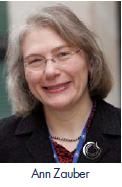
Ann Zauber, Ph.D., is a member of the Department of Epidemiology and Biostatistics at Memorial Sloan-Kettering Cancer Center and Principal Investigator for a Colon CISNET modeling grant in consortium with ErasmusMC of Rotterdam, the Netherlands. She also is the Principal Investigator for the Colon CISNET coordinating center.
Dr. Zauber's background is in biostatistics (Ph.D.), health services, and epidemiology (postdoctoral), with a primary focus on colorectal cancer prevention. She is the biostatistician for the randomized trials of the National Polyp Study, National Colonoscopy Study, and Adenoma Prevention with Celecoxib Trial. She first became involved in microsimulation modeling when ErasmsusMC investigators asked to use the National Polyp Study to validate their colorectal cancer microsimulation model. Dr. Zauber was intrigued by the use of microsimulation models to further explore the observed findings of a clinical trial and to test additional hypotheses. When the CISNET modeling program was developed, she collaborated with Marjolein van Ballegooijen, Rob Boer, and Dik Habbema to form a Memorial Sloan-Kettering and Erasmsus consortium using the Erasmus microsimulation model that was validated against multiple clinical trials, including the National Polyp Study. These investigators have been part of CISNET since 2002. The National Polyp Study continues to be a source of interest in how best to stratify adenoma patients as higher and lower risk with more and less frequent surveillance colonoscopy.
New and evolving tests and technologies have been developed for colorectal cancer screening, including the fecal immuno chemical test (FIT), DNA stool test, and CT-colonography. Deciding whether to adopt these newer tests for general population screening requires a standardized assessment of the risks and benefits of the new tests relative to tests currently in use. The Centers for Medicare and Medicaid Services (CMS) is responsible for assessing whether a new test should be covered by Medicare and, if so, the level of reimbursement. The Colon-CISNET modelers were asked by the Agency for Healthcare Research and Quality (AHRQ) to use microsimulation modeling to assess the risks and benefits of these newer tests to inform health policy for National Coverage Determinations for CMS. The CISNET modelers conducted cost-effectiveness analyses for FIT in 2003 (van Ballegooijen, 2003), for the DNA stool test in 2007 (Zauber, 2007), and CT colonography in 2008. The analyses determined the per-test cost that would provide comparable cost-effectiveness with currently reimbursable tests. The modeled threshold value for FIT was $13 to $18 (CMS approved FIT for reimbursement at $22 per test). The threshold value for the DNA stool test was $34 to $51 (the coverage decision by CMS is pending). The threshold value for CT-colonography will be reported in fall 2008. Several FITs are now available in the United States for CRC screening.
This year, the Colon CISNET modelers provided a decision analysis for the U.S. Preventive Service Task Force (USPSTF) for age to begin, age to stop, and intervals of re-screening for colon cancer screening for multiple screening tests. As in the past, the USPSTF used a comprehensive evidence review of the literature to assess updates to its recommendations. This was the first time, however, that the Task Force used decision analysis in combination with the systematic evidence review to inform its decisions. CISNET models provided standardized comparisons of 145 screening strategies using the best available evidence for USPSTF consideration. Several of these screening strategies provided similar gains in life-years-– with the proviso of equally high adherence for all aspects of the screening process. Under these conditions, the best screening strategies were high-sensitivity FOBT (Hemoccult SENSA or fecal immuno-chemical test) performed annually, flexible sigmoidoscopy every 5 years with Hemoccult SENSA every 2 to 3 years, and colonoscopy every 10 years. Annual FOBT with a lower sensitivity test (Hemoccult II) and flexible sigmoidoscopy alone resulted in fewer life-years gained relative to other strategies. These analyses confirmed the current recommendation to begin screening at age 50 in an asymptomatic general population and showed that stopping at age 75 after consecutive negative screenings since age 50 provides almost the same benefit as stopping at age 85 but with substantially fewer colonoscopy resources used and less risk of complications. The CISNET modelers worked closely with AHRQ (Drs. William Lawrence and Mary Barton) and members of the Task Force in developing the questions to be addressed. The Task Force requested that the analysis be based on colonoscopy resources rather than cost. The number of colonoscopies required to deliver a screening strategy per 1,000 screened represented resource allocation and risks of colonoscopy complications. The CISNET report to AHRQ will be part of the publication in the Annals of Internal Medicine of the USPSTF recommendations with accompanying evidence-based literature review and the CISNET-modeled cost-effectiveness analysis. Two Colon CISNET models (MSK-Erasmus and University of Minnesota) independently derived the decision analysis for the Task Force. This comparative modeling approach added credibility to the results and served as a sensitivity analysis on the underlying structural assumptions of the models, particularly pertaining to the unobservable natural history of colorectal cancer. Implementation of the findings from the model will provide CRC strategies that effectively use endoscopy resources with limited complications and increased savings of years lived.
Dr. Zauber greatly enjoys the challenges posed by CISNET to combine biostatistics, epidemiology, and health policy to provide for the best evidence-informed decisions for health policy. She benefits from and appreciates the collegial and informative collaborations with fellow CISNET modelers that improve modeling and foster finding the best possible answers.
Selected Publications From the CRC CISNET MSK-Erasmus Consortium:
Lansdorp-Vogelaar I, van Ballegooijen M, Zauber AG, Boer R, Wilschut J, Winawer SJ, Habbema JDF. Individualizing colonoscopy screening by gender and race. Gastrointestinal Endoscopy. In Press.
Loeve F, Boer R, Zauber AG, van Balleooijen M, van Oortmarssen GJ, Winawer SJ, Habbema JD. National Polyp Study data: evidence for regression of adenomas. Int J Cancer 2004 Sep 10;111:633-9.
van Ballegooijen M, Habbema JDF, Boer R, Zauber AG, Brown ML. Report to the Agency for Healthcare Research and Quality: a comparison of the cost-effectiveness of fecal occult blood tests with different test characteristics in the context of annual screening in the Medicare population. August, 2003. Available at http://www.cms.hhs.gov/coverage/download/id87.zip.
Vogelaar I, van Ballegooijen M, Schrag D, Boer R, Winawer SJ, Habbema JD, Zauber AG. How much can current interventions reduce colorectal cancer mortality in the U.S.? Mortality projections for scenarios of risk-factor modification, screening, and treatment. Cancer 2006 Oct 1;107(7):1624-33.
Winawer SJ, Zauber AG, O'Brien MJ, Ho MN, Gottlieb L, Sternberg SS, Waye JD, Bond J, Schapiro M, Stewart ET, Panish J, Ackroyd F, Kurtz RC, Shike M, National Polyp Study Workgroup. Randomized comparison of surveillance intervals after colonoscopic removal of newly diagnosed adenomatous polyps. N Engl J Med 1993 Apr 1;328:901-6.
Zauber AG, Lansdorp-Vogelaar I, Wilschut J, Knudsen AB, Van Ballegooijen M, Kuntz KM. Cost-effectiveness of DNA stool testing to screen for colorectal cancer: report to AHRQ and CMS from the Cancer Intervention and Surveillance Modeling Network (CISNET) for MISCAN and SimCRC Models. December 20, 2007. Available at: CMS Reports: Cost-Effectiveness of Screening Tests for Colorectal Cancer.
Zauber AG, Lansdorp-Vogelaar I, Knudsen AB, Wilschut J, van Ballegooijen M, Kuntz KM. Evaluating test strategies for colorectal cancer screening: a decision analysis for the U.S. Preventive Services Task Force. Ann Internl Med. In Press.
Selected CISNET Publications
Breast Working Group
Lee SJ, Zelen M. Mortality modeling of early detection programs. Biometrics 2008 Jun;64(2):386-95. Epub 2007 Aug 28.
Mandelblatt JS, Potosky AL. On the road to improving the quality of breast cancer care: a distance still to travel. Med Care 2008 Aug;46(8):759-61.
Colorectal Working Group
Jeon J, Meza R, Moolgavkar SH, Luebeck EG. Evaluation of screening strategies for pre-malignant lesions using a biomathematical approach. Math Biosci 2008 May;213(1):56-70. Epub 2008 Feb 26.
Miglioretti DL, Brown ER. A marginalized diffusion model for estimating age at first lower endoscopy use from current-status data. J R Stat Soc Ser C Appl Stat 2008;57(1):61-74.
Lung Working Group
Levy DT, Tworek C, Hahn EJ, Davis RE. The Kentucky SimSmoke tobacco policy simulation model: reaching Healthy People 2010 goals through policy change. South Med J 2008 May;101(5):503-7.
Meza R, Hazelton WD, Colditz GA, Moolgavkar SH. Analysis of lung cancer incidence in the Nurses' Health and the Health Professionals' Follow-Up Studies using a multistage carcinogenesis model. Cancer Causes Control 2008 Apr;19(3):317-28. Epub 2007 Dec 6.
Prostate Working Group
Etzioni R, Gulati R, Falcon S, Penson DF. Impact of PSA screening on the incidence of advanced stage prostate cancer in the United States: a surveillance modeling approach. Med Decis Making 2008 May-Jun;28(3):323-31. Epub 2008 Mar 4.
Etzioni R, Tsodikov A, Mariotto A, Szabo A, Falcon S, Wegelin J, DiTommaso D, Karnofski K, Gulati R, Penson DF, Feuer E. Quantifying the role of PSA screening in the US prostate cancer mortality decline. Cancer Causes Control 2008 Mar;19(2):17581. Epub 2007 Nov 20.
Telesca D, Etzioni R, Gulati R. Estimating lead time and over-diagnosis associated with PSA screening from prostate cancer incidence trends. Biometrics 2008 Mar;64(1):10-9. Epub 2007 May 14.
Surveillance Research Program Staff
Office of the Associate Director (OAD)
Telephone: 301-496-8506
Fax: 301-480-4077
Brenda K. Edwards, Ph.D., Associate Director
Betsy Flagg, Program Analyst
Amy Garson, Program Analyst
Terri Harshman, Program Analyst
Stephen Meersman, Ph.D., Health Scientist Administrator
Lawrence Hwang, M.P.H., CRTA Fellow
Danny Lin, CRTA Fellow
Katrina Mackrain, M.P.H., CRTA Fellow
Marsha Reichman, Ph.D., Surveillance Research Coordinator
Judith Swan, M.H.S., Public Health Advisor
Cancer Statistics Branch (CSB)
Telephone: 301-496-8510
Fax: 301-496-9949
David Stinchcomb, M.A.-Geo/M.S.C.S., Chief
Peggy Adamo, R.H.I.T., C.T.R., Public Health Analyst
Sean Altekruse, D.V.M., M.P.H., Ph.D., Epidemiologist
Lin Clegg, Ph.D., Mathematical Statistician
Lois Dickie, C.T.R., Public Health Analyst
Milton Eisner, Ph.D., Public Health Statistician
Marie-Josephe Horner, M.S.P.H., Epidemiologist
Nadia Howlader, M.S., Biostatistician
Carol Johnson, C.T.R., Public Health Analyst
Carol Kosary, M.A., Mathematical Statistician
Denise R. Lewis, Ph.D., M.P.H., Epidemiologist
Barry Miller, Dr.P.H., Epidemiologist
Antoinette Percy-Laurry, M.S.P.H., Public Health Analyst
Lynn Ries, M.S., Health Statistician
Jennifer Ruhl, R.H.I.T., C.T.R., Public Health Analyst
Zaria Tatalovich, Ph.D., Health Statistician
Statistical Research and Applications Branch (SRAB)
Telephone: 301-435-7739
Fax: 301-480-2046
Eric J. (Rocky) Feuer, Ph.D., Chief
Kathy Cronin, Ph.D., Mathematical Statistician
Bill Davis, Ph.D., Mathematical Statistician
Rose Fredua, Program Analyst
Lan Huang, Ph.D., Mathematical Statistician
Angela Mariotto, Ph.D., Mathematical Statistician
Division of Extramural Activities Support (DEAS)
Telephone: 301-496-8506
Fax: 301-480-2046
Oluyemisi Akinneye, B.S., DEAS Task Leader
Ann Olumba, Extramural Support Assistant
Miquel Sample-Jubilee, Extramural Support Assistant
Administrative Resource Center (ARC)
Telephone: 301-451-9470
Fax: 301-435-5071
Mary Kashanchi, Deputy ARC Manager
Steve Brown, Purchasing Agent
Vicky Schneider, Administrative Officer
Rhonda Turner, Administrative Technician
Donna Wade, Administrative Officer
Parting Shot...
The Alaska Native, Cherokee Nation, and Iowa Tumor Registries survived deployment of SEER*DMS and have earned T-shirts to prove it.

